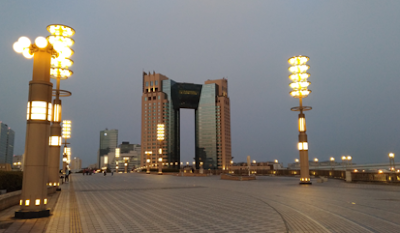I will write a story of the lumberyard history in Koto-City.
In Edo period, Edo-city was filled with houses made of wood, so fire was a regular occurrence. It was important where the lumberyard should be located because the lumberyard itself fanned a fire.
Back to the early 17th century, beginning of the Edo period, a lumberyard was in center of Edo-city, near Edo castle (current Imperial Palace). Triggered by a big fire in 1641, the Tokugawa shogunate, government decided to move the lumberyard to Fukagawa where is a big open space and easy to transport lumbers on the water.
The new lumberyard was called Moto-Kiba, which means original lumberyard on east side of Sumida-River.
Followed by 1641, the biggest fire ever happened in 1657, which burned out almost two third of the Edo-city (see 'The biggest fire in 1657'). That made the government decide to develop a plan to expand the Edo-city into eastside of Sumida-River.
Fukagawa, near Nihonbashi across the Sumida-River where retail business gathered, was required to supply goods as wholesaler. Because of warehouse supremacy, 60 years later after Moto-Kiba started, it was forced to move again.
Fig. Fukagawa Lumberyards, One Hundred Famous Views of Edo
(Source: National Diet Library Digital Collections)
The lumberyard moved to Kiba-Area east of Moto-Kiba in 1701 after temporary stay in Sarue-Area. Kiba lumberyard was prepared by the Lumber-Corp members at their cost, which size was 75 acres. The preparation included water channels, bridges on the channels and bank surrounding the area (see 'Kiba in winter'). Between 1701 and 1974, Kiba-Area flourished for 270 years thanks to not only the lumberyard business, but a culture respects. During the period, diverse people such as owner of lumberyard, wood sewer, carpenter, Kawanami acted in the lumberyard (see 'Wood sewer in Kiba'). Most of lumbers used for house building in Edo-city were produced within Kiba-Area. Edo-city was biggest city in the world with more than one million population those days. Among people in the lumber business, the most famous merchant, an owner of lumberyard was Bunzaemon Kinokuriya, who made a big money supplying lumber.
He also undertook major projects including Ueno-Kaneiji temple construction with the government’s tremendous help.
The lumber merchants lifted teahouse or Chaya business to entertain merchant’s guest. They enjoyed drinking and conversation with geishas (see 'Chaya'). This culture raised a sense of ‘Iki’, an aesthetic sense that values being sophisticated, stylish, casual, smart, and considerate.
Lumbers were cut and carried off mountains all over Japan. They were transported to Edo-city by Kawanami. Kawanami was assigned all responsibilities by a merchant.
He selects woods in the forest, transports them making a raft in the water (see 'Kawanami and a raft').
He negotiated the sales price with suppliers of houses and temples. Kawanami created the cultures such as Kiyari, labor song and Kakunori, a play to rotate a squared lumber using both legs.
Kiba-Area became inland for Tokyo-Bay being reclaimed and had problems of land subsidence, water pollution and others. The lumberyard was forced to move again to the southern direction of Kiba-Area, Shin-Kiba. It started as huge industrial park with 600 companies in 1974 (see 'Shin-Kiba lumberyard at early time'). Glory of Shin-Kiba, however could not last long because the way of the lumber business changed from pulpwood to processed wood.
On the site of Kiba-Area, Kiba-Park was developed and opened to the public in 1992 (see 'Kiba-Park'). The park was developed based on disaster prevention plan by Tokyo Metropolitan Government. Its size is 60 acres. It works as a relaxing place like New York Central Park.
There is Museum Of contemporary art Tokyo in the park (see 'Museum of contemporary art').
You will have a fun looking around the park. If lucky, you can see Kakunori play someday in October (see 'Kakunori play').
B.I.




